Before listing animals with masks, it is important to know just what a mask is. A mask is not just dark circles around the eyes, otherwise, the giant panda, with its famous black eye patches, could be said to be wearing a mask. Masks are also not markings such as black stripes over the eyes. A mask for these purposes is dark circles of feathers, fur, or scales that surround both eyes but do not extend to the entire nose or muzzle, if the animal has one. The dark circles also don’t extend all the way to the crown of the head but can extend down the cheeks. In other words, a mask makes the animal look somewhat like a cartoon bandit.
A mask helps to break up the pattern of the face, making it easier for the animal to stay hidden. It also helps to obscure the shine of eyes and hides the shape of eyes. While a mask may seem like a bold marking, it is very effective at making an animal harder to see when it is tucked in among tree branches, brush, or other plants. With that in mind, here are the top 10 masked animals.
#10: Powder Blue Surgeonfish
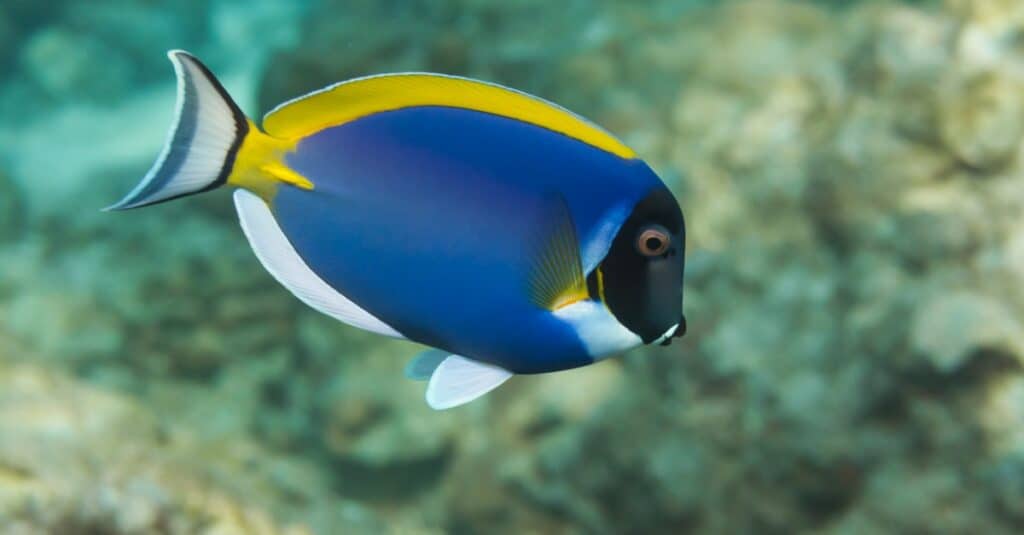
©iStock.com/tae208
Native to the Indian Ocean, this nine-inch-long fish is a popular aquarium pet. Besides its black mask, much of the body is blue, and the dorsal fin is yellow. There’s a white patch from the throat to the pectoral fin. It has a compressed, oval body and a tiny, beaky mouth, the better to scrape algae from coral and rocks. The mouth is separated from the mask by a white band.
What gives the fish its name is a scale at the root of the tail which is not only as sharp as a surgeon’s scalpel but has a protective covering of poisonous slime. There’s also a spine in the pelvic fin and four to nine spines in its dorsal fin. As a pet, the surgeonfish is a bit too aggressive to be kept in a tank with other fish.
#9: Masked Flowerpiercer
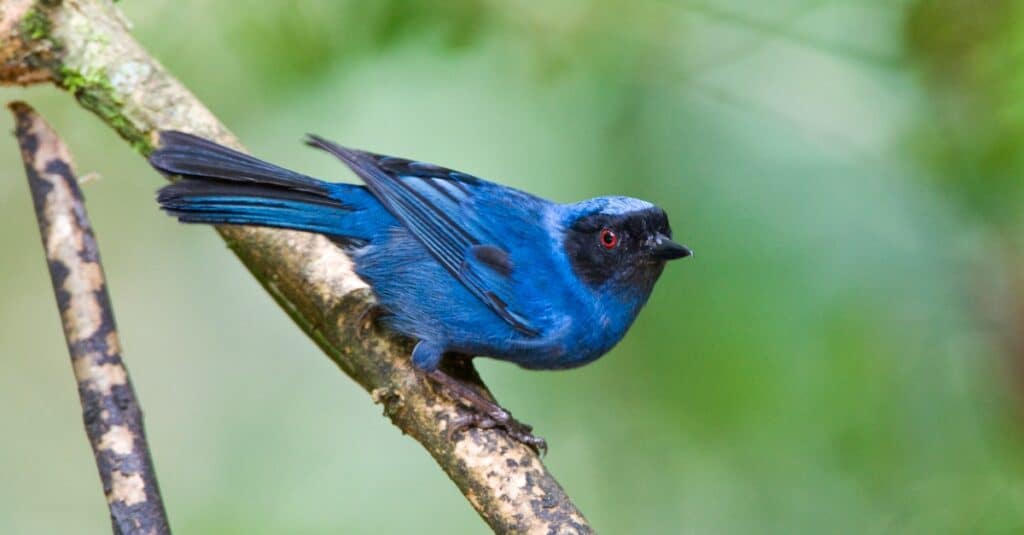
©iStock.com/AGAMI stock
This masked bird gets its name because it takes nectar from flowers. It does this through a tiny hook at the end of its beak which it uses to slice open the flower’s nectary. It’s only found in the mountain forests of the Andes. The bird, which is a member of the tanager family, is about six inches long. The bright red eyes of the male peek out from its black mask, and the rest of the body is electric blue. The female is duller.
Besides nectar, the bird also eats fruit and insects. Though it may steal nectar, it also helps pollinate the Axinaea sclerophylla tree. The bird likes to eat the stamens of its flowers, but when it pulls one out it releases the pollen which lands on the bird’s head. When the bird goes to eat the stamens of another flower, the flower is pollinated.
#8: Eurasian Penduline Tit
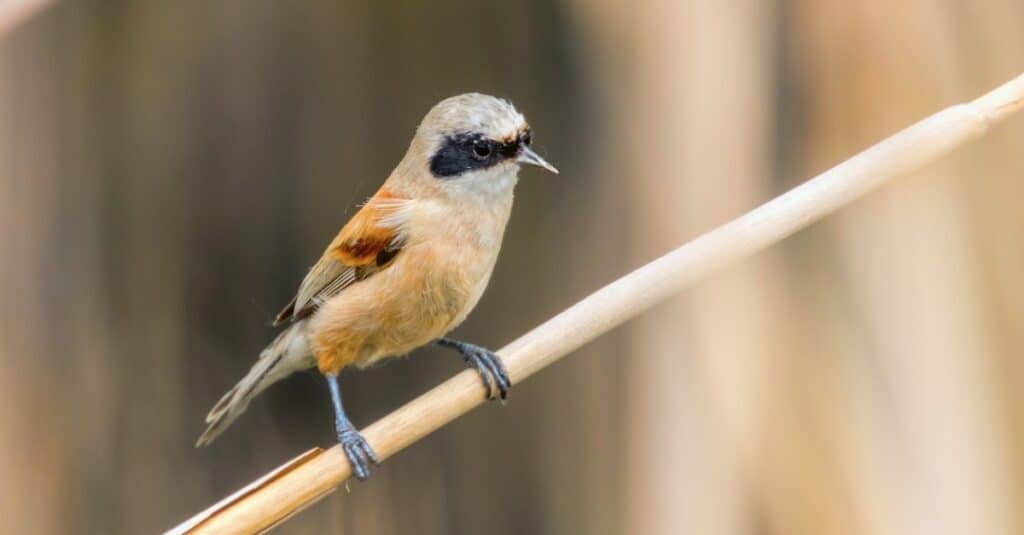
©iStock.com/Allexxandar
This tiny bird gets its name because it builds hanging nests over bodies of water. Only 2.96 to 4.33 inches long, it has a tiny, sharp bill, short round wings, and a notched tail as well as a black mask. The rest of the body is shades of brown. It is a fairly common bird found in Palearctic lands, which includes northern Africa, part of the Middle East, Europe, Russia, and northern Asia. It eats insects in the summer and seeds in the winter.
The bird’s nest is made of down and willow seeds and often takes weeks to build since the birds have to pound the materials until they resemble felt. It has a tubular entrance at the bottom that leads up into the nest chamber. They are so sturdy that Polish people used to repurpose the nests as shoes for children.
#7: Maned Sloth
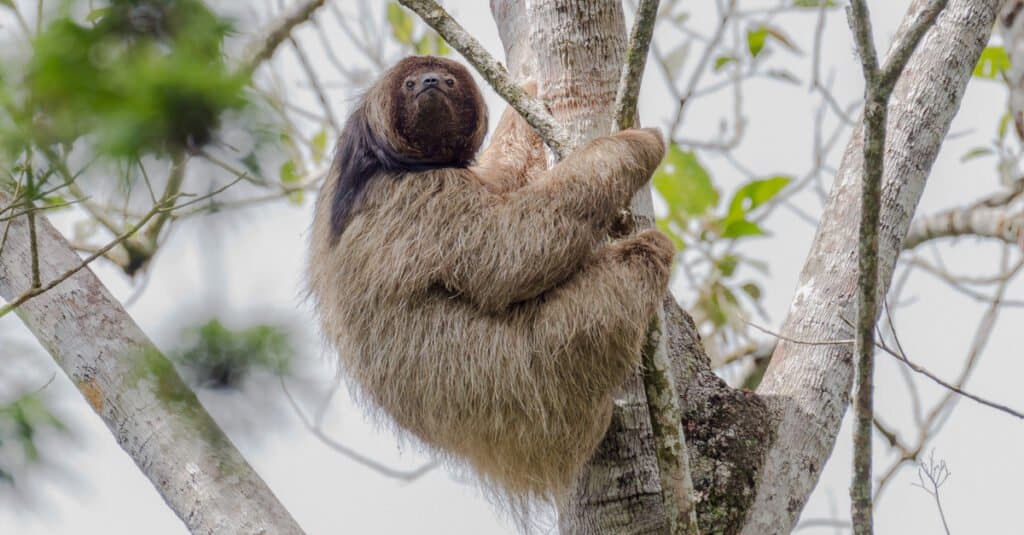
©Eduardo Menezes/Shutterstock.com
The maned sloth is endemic to Brazil, where it lives in the trees of the coastal rainforests. The sloth has gray or pale brown fur and a double coat. The top is long while the undercoat is dense and short. The animal’s topcoat is also a mini-ecosystem of mites, algae, and insects. It has a little head, and its masked eyes tilt backward. The animal gets its name because it has a black mane over its neck and shoulders. It’s longer in the males.
Male maned sloths are 22 to 28 inches long and weigh between 8.8 and 16.5 pounds, while females are larger. Unlike some of the other animals with masks mentioned, the maned sloth is diurnal. This doesn’t mean that it’s active during the day since it spends most of the day sleeping. It does wake up long enough to eat the leaves of the tree it lives in. The sloth does everything in its tree because it doesn’t have the muscle mass to walk or stand up. It only climbs down to relieve itself or remove to another tree.
#6: Slender Loris

©iStock.com/slowmotiongli
This little primate is found in the forests of Sri Lanka and India. Its huge, round, front-facing eyes stare out of its mask. As it is one of those animals that come out at night, it needs those enormous eyes to see well in the dark. Its face mask is bisected by a white stripe, and it has dense, soft fur that is often brownish above and silvery gray below. It usually eats insects but will also eat plant material as well as bird’s eggs and small vertebrates. It simply snatches what it wants with its hands. During the day it sleeps holding on to tree branches with its fingers and toes.
The slender loris is about seven to 10 inches long and lacks a tail. In the past, its cautious movements made it hard for predators to see, but habitat destruction and hunting have caused its population to decline. Its conservation status is now endangered.
#5: Spectacled Monarch
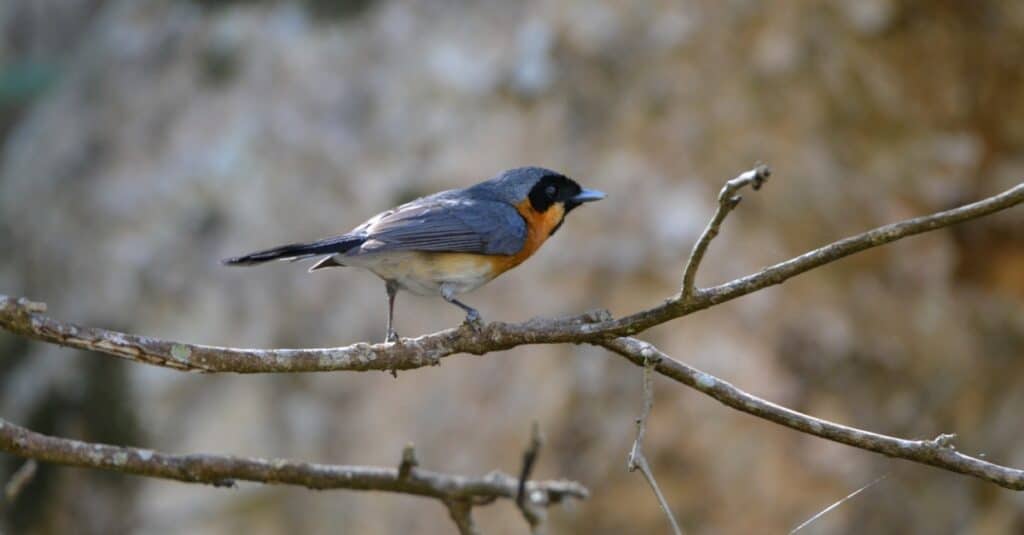
©iStock.com/nmulconray
This masked animal isn’t a butterfly but a bird, and it’s native to the tropical, subtropical forests of Australia, Papua New Guinea, and Indonesia. Besides its black mask, this bird can have underparts of different colors, from orange to white, depending on where it lives. Its back, head, and tail are slate-colored. It’s an insectivore and hops about the underbrush catching insects and spiders. About six inches long, both spectacled monarch sexes look alike.
#4: Spectacled Owl
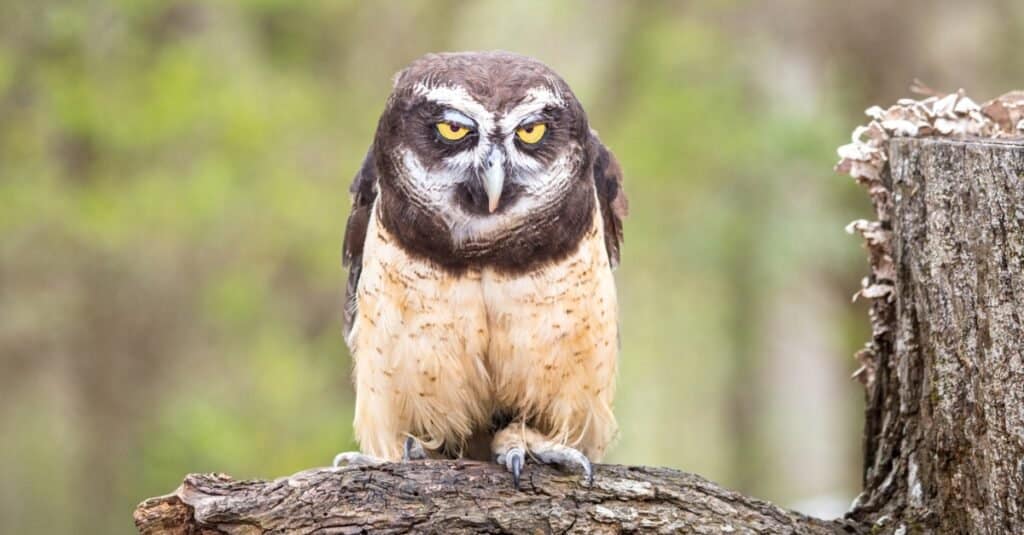
©iStock.com/garytog
Another of the masked animals is the spectacled owl. Found in the tropical rainforests of Mexico down to Central and South America and into Trinidad and Tobago, this owl’s huge yellow eyes stare out from its dark mask, and it is the only kind of owl in the Pulsatrix genus to have yellow eyes. It is a big owl that’s 16 to 21 inches long and weighs between one and 2.76 pounds. As with many types of owls, the females are bigger and heavier. Spectacled owls nest in tree cavities. The female lays at most two eggs, though only one chick will live to fledge. As they have no real predators and are hardy animals, spectacled owls can live as long as 35 years even in the wild.
#3: Black-footed Ferret
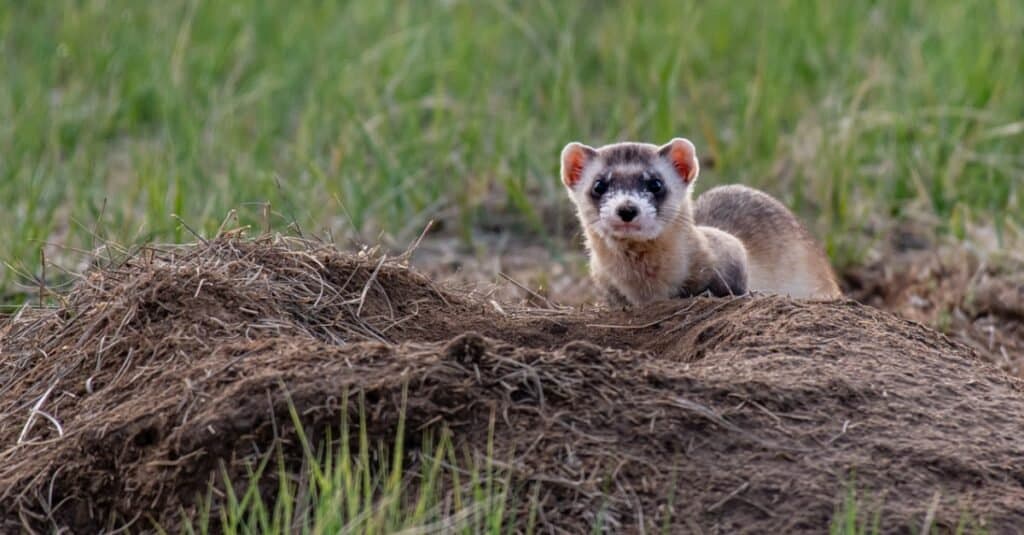
©iStock.com/Kerry Hargrove
The black-footed ferret was once on the verge of extinction but has recovered to the point where it’s only endangered. Another of the beasts that come out at night, this pretty ferret has a black mask that joins black fur on its feet, ears, and tail. The rest of the body is buff. It has the trademark tubular build seen in other types of mustelids, and males range from 19.7 to 21 inches long while females are smaller. Native to the prairies of the United States, it is a carnivore whose main meal is the prairie dog.
#2: Raccoon Dog
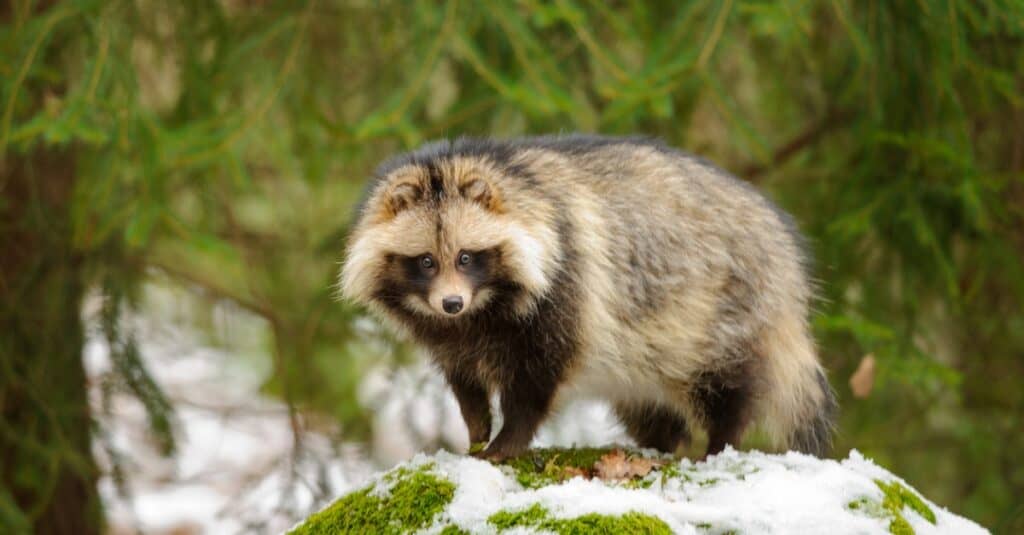
©iStock.com/sduben
Is it a dog or is it a raccoon? The raccoon dog is one of several types of dog. The raccoon part comes because it has a mask-like a raccoon and, indeed, if you only saw a picture of the dog’s face, you’d swear that it was a raccoon, even though they are not related. Found in East Asia and the northern part of Vietnam and now introduced into Europe, the raccoon dog is a little bigger than a raccoon at 18 to 28 inches long. Yet it weighs about the same on average as a raccoon and has a maximum weight of only 22 pounds. It has a robust body, and its lush fur was what caused it to be introduced into Europe for the fur trade.
Raccoon dogs are omnivores that are found in forests and prefer to live near bodies of water. Like its fellow bandit the raccoon, the raccoon dog has no problem raiding human habitations for food. It’s also the only type of dog that hibernates.
#1: Raccoon

©iStock.com/amadeusamse
The raccoon is the standard for animals with masks, and a mask is fitting for an animal that has a reputation as a little bandit. Certainly, its skill at twisting off the tops of garbage cans to get to the inside is unparalleled for a little animal. One of the masked animals that come out at night, the raccoon not only wears a mask but has a bushy striped tail and nimble front paws that it uses to get into things. It’s about 16 to 18 inches long and weighs from 11 to as much as 57 pounds. It’s an omnivore that can thrive in a variety of habitats. Native to a large swathe of North America, the raccoon is considered an invasive species in some places. Though they can live as long as 20 years in captivity, most raccoons don’t make it much past three years due to hunting and ending up as roadkill.
Some people wonder if the raccoon’s distant cousin the red panda also wears a mask. Can they be called panda raccoons? Can the facial markings of these “panda raccoons” really be called masks. Their markings, which are described as teardrops and badges, are white against the animal’s red fur. This blog concludes that the markings on these endangered animals are “mask adjacent.” By the way, “panda raccoons” are even more distantly related to the giant panda than they are to the raccoon.
Summary
Our research shows that 10 of the most popular animals with masks around their eyes are as follows:
| Number | Animal |
|---|---|
| 1. | Raccoon |
| 2. | Raccoon Dog |
| 3. | Black-footed Ferret |
| 4. | Spectacled Owl |
| 5. | Spectacled Monarch |
| 6. | Slender Loris |
| 7. | Maned Sloth |
| 8. | Eurasian Penduline Tit |
| 9. | Masked Flowerpiercer |
| 10. | Powder Blue Surgeonfish |
Up Next…
- Watch-octopuses-pull-off-impossibly-good-camouflage-in-underwater-video Check out another cool camouflage adaptation.
- Top 10 Animals with Camouflage So Good they’re Basically Invisible These animals take camouflage to a whole new level.
- Why Do Giraffes Have Spots? Do all those spots help giraffes stay hidden? Find out here.
The photo featured at the top of this post is © iStock.com/amadeusamse
Thank you for reading! Have some feedback for us? Contact the AZ Animals editorial team.







